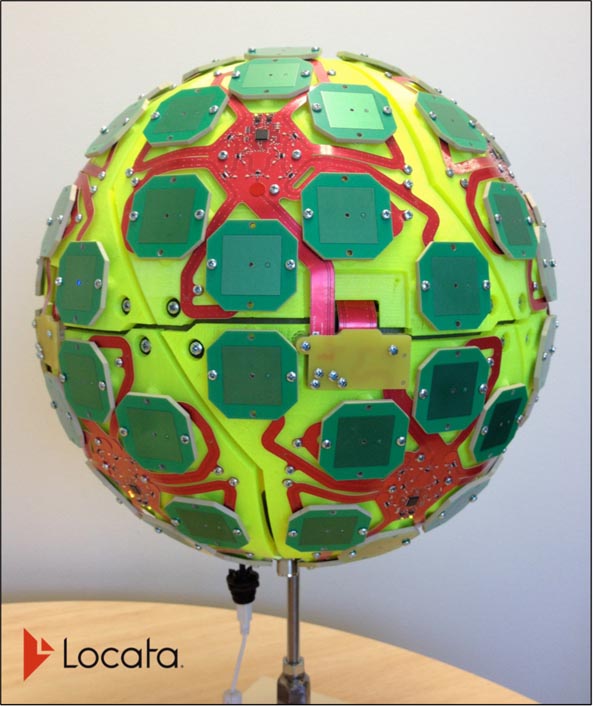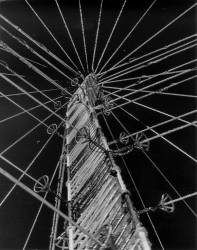 Locata’s VRay Orb-80 antenna
Locata’s VRay Orb-80 antennaThe Air Force Institute of Technology (AFIT) and Locata Corporation, based in Canberra, Australia, have announced the signing of a co-operative research & development agreement (CRADA) to build and demonstrate new Locata multipath mitigation technology for use in GPS receivers. This cooperation is expected to leverage many years of proprietary Locata ground-based technology development to bring completely new capabilities to satellite-based GPS receivers.
The Air Force Institute of Technology (AFIT) and Locata Corporation, based in Canberra, Australia, have announced the signing of a co-operative research & development agreement (CRADA) to build and demonstrate new Locata multipath mitigation technology for use in GPS receivers. This cooperation is expected to leverage many years of proprietary Locata ground-based technology development to bring completely new capabilities to satellite-based GPS receivers.
The CRADA is specifically directed to evaluate Locata’s patented VRay switching antenna and new correlator technologies for multipath mitigation in position receivers that run at GPS frequencies. Locata engineers are transferring to AFIT the knowledge and experience they have gained with existing commercial Vray systems.
This will allow AFIT researchers and engineers to familiarize themselves with the new antenna’s characteristics, and provide AFIT with an essential platform to develop GPS-specific versions of Locata’s correlator and switching algorithms. AFIT will first design and build a GPS-frequency multi-element switching antenna prototype that is based on Locata VRay patents. When built, AFIT intends to use their GPS receiver and this prototype Vray to physically demonstrate the feasibility of using Locata technology to improve GPS receiver performance.
After these initial prototypes are built, AFIT plans to design and test several other GPS-based versions of Locata’s flexible switching antenna array to assess how Locata’s VRay antennas can be used in situations of particular interest to the military. Designs already discussed with Locata include stand-alone antennas, arrays conformed to a vehicle’s frame (for example, flattened for a Humvee’s roof or curved for aircraft fuselages), and a version built into helmets.
As a first step in implementing this CRADA collaboration, AFIT personnel visited Locata’s head office in April for a week of detailed, wide-ranging introduction to the design fundamentals for this new type of antenna. A video describing the VRay technology can be seen here.
Locata hosted John Raquet, director of AFIT’s Advanced Navigation Technology Center, and AFIT engineers Peter Collins and Jason Barhorst in multiple engineering meetings at which Locata’s current production version antenna was revealed for the first time, and then closely analyzed.
AFIT and Locata engineers then workshopped the modification and design choices required to integrate Locata design into a GPS form factor.
Raquet says, “If this CRADA is successful, Locata’s technology could enable a significantly improved technical performance and reduction in the cost of multiple-element GPS antennas. This will enable much wider adoption of the technology, resulting in more reliable GPS positioning for more users. We are excited to investigate this technology advance for the benefits it will potentially bring to American warfighters.”
Nunzio Gambale, Locata’s CEO and co-founder, says, “We are incredibly proud to once again be involved in a CRADA with the Air Force Institute of Technology, developing on the cutting-edge of navigation technology. I’m certain that our collaboration, along with access to the USAF’s unmatched prototyping and testing capabilities, will deliver ground-breaking functionality for future GPS devices”.
AFIT expects at least one Masters Degree to be awarded for the research tasks involved in the CRADA. Work against the approved CRADA project plan has begun and involves several other participants providing administrative and lab support to AFIT and Locata.
A final report produced by this CRADA will include results and measured performance of the Locata-enhanced GPS receiver and other design considerations gleaned from AFIT’s experience with the new Locata antenna and correlators as applied to GPS.





